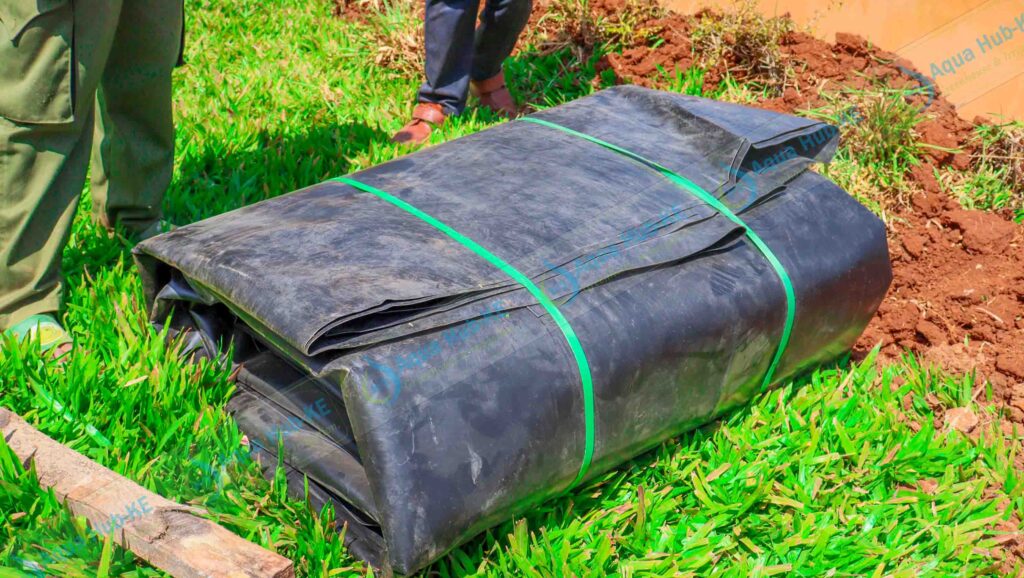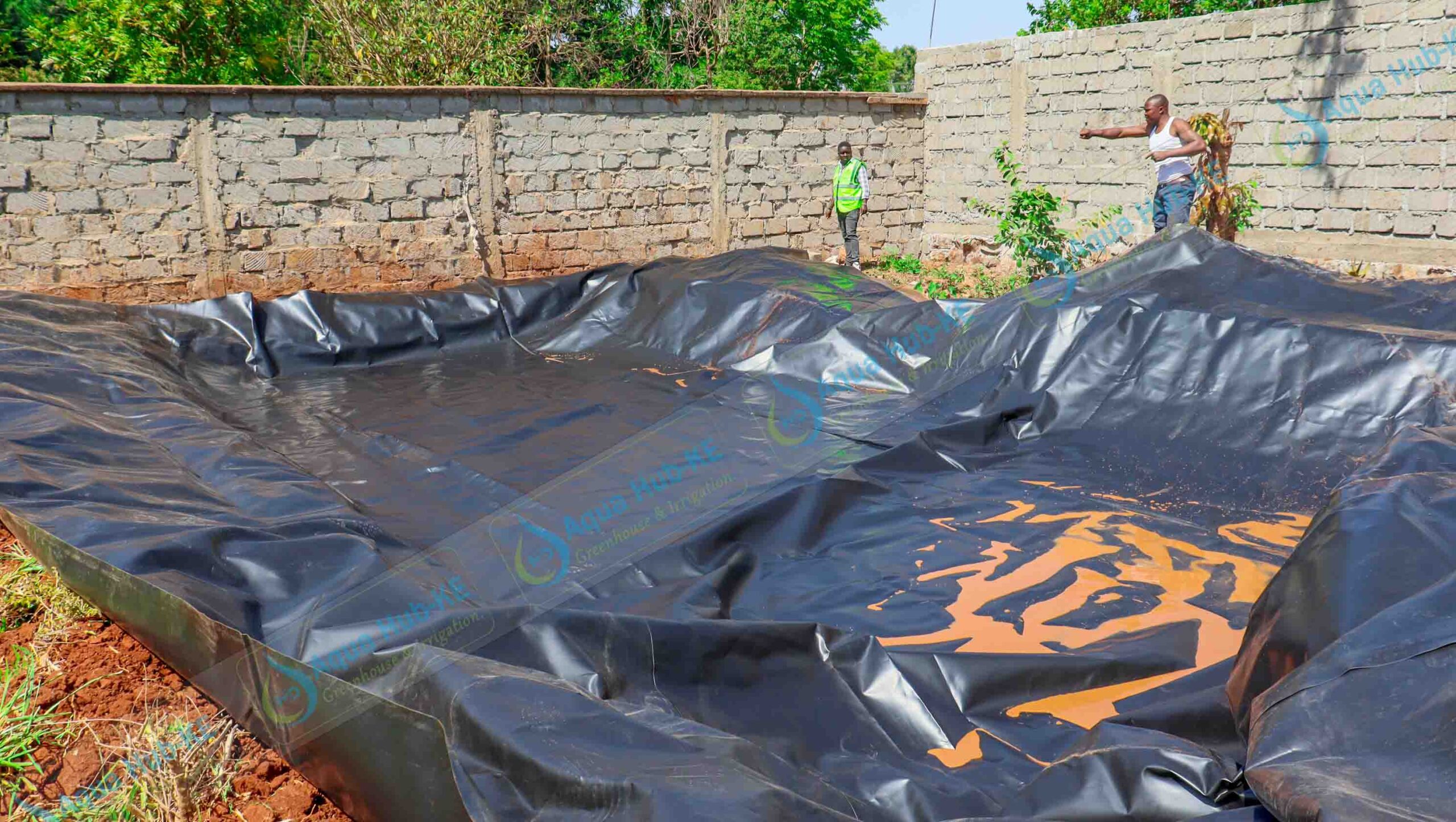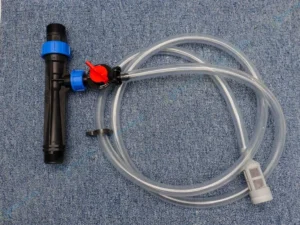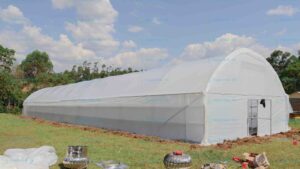Water Conservation is now easier due to the affordable cost of Dam Liners in Kenya. Dam liners are designed to create an impermeable barrier ensuring every drop of water remains for use. If you are looking to secure a reliable water source, understanding dam liners is your first step towards sustainable water management.
Aqua Hub LTD offers quality and affordable Dam Liners.
Call 0790719020
What Are Dam Liners ?
Dam liners are waterproof membranes used to line the bottom and sides of dams, ponds, reservoirs, and even canals.

Why Do We Need Dam Liners?
The primary function of a dam liner is to prevent water from seeping into the ground, a common problem in areas with porous soil. Without a liner, a significant portion of stored water can be lost, rendering water harvesting efforts largely ineffective.
Cost of Dam Liners in Kenya
The cost of dam liners in Kenya varies from KES 150 to KES 450 per square meter depending on the material type, and liner thickness.
Cost of Dam Liners per Square Meter
- 0.3mm LDPE: KES 150
- 0.5mm PVC: KES 230
- 0.75mm HDPE: KES 350
- 1.0mm HDPE: KES 450
Factors influencing Cost of Dam Liners
Liner Thickness: Thicker liners are more expensive but offer greater durability and longevity.
Material Type: HDPE is generally more costly than PVC or LDPE due to its superior properties and longer lifespan.
Dam Size: Larger dams require more material, thus increasing the total cost.
Specifications and Features: What Makes a Good Dam Liner?
Dam Liners vary in durability, thickness and efficiency according to the types available in the market.
High-Density Polyethylene (HDPE) Liners
Specifications: Available in thicknesses ranging from 0.3mm to 1.0mm, with some suppliers offering up to 3.0mm for heavy-duty applications.
Features
- Superior Durability: Highly resistant to punctures, tears, and abrasive surfaces.
- Excellent UV Resistance: Crucial for Kenya’s intense sun, preventing degradation and extending lifespan (often 15-30 years).
- Chemical Resistance: Impervious to a wide range of chemicals, making them ideal for various water quality and industrial uses.
- High Tensile Strength: Can withstand significant water pressure and ground movement.
- Suitable for Large Projects: Preferred for extensive agricultural reservoirs, large fish farms, and industrial containment.
Polyvinyl Chloride (PVC) Liners
Specifications: Commonly found in thicknesses from 0.5mm to 1.0mm.
Features:
- Flexibility: More pliable and easier to handle during installation, conforming well to irregular shapes.
- Cost-Effective: Generally, more affordable than HDPE, making them a good option for smaller budgets.
- Good for Medium-Sized Projects: Suitable for small to medium-sized ponds and temporary water storage.
- Moderate Lifespan: Typically, last 10-15 years with proper care.
Low-Density Polyethylene (LDPE) Liners:
Specifications: Thinner gauges, often around 0.3mm to 0.5mm.
Features
- Highest Flexibility: Extremely soft and easy to install.
- Most Affordable: Best for temporary water storage or projects with very smooth surfaces.
- Shorter Lifespan: Generally, it can last for 5-10 years.
Making the Right Choice: Purchase Considerations for Your Dam Liner
Intended Use: Are you lining a fishpond, an irrigation dam, or an industrial containment pond? This will dictate the required material and thickness. For fish farming, ensure the liner is aquaculture-safe and non-toxic.
Dam Size and Shape: The dimensions of your dam or pond will determine the overall quantity of liner needed. Irregular shapes may require more cutting and welding.
Soil Type: If your soil is rocky, a thicker, more puncture-resistant liner (like HDPE) is essential. For smoother surfaces, thinner sizes are ideal.
Budget: Dam liner prices vary significantly by material and thickness. Balance your budget with the required durability and lifespan.
Lifespan Expectations: How long do you need the liner to last? For long-term investments, HDPE is the clear winner.
Supplier Reputation: Purchase from reputable suppliers who offer quality materials, installation services, and after-sale support.
How to Install a Dam Liner
Proper installation is critical to the dam liner’s performance and longevity.
Site Preparation
Excavation: Dig the dam or pond to the desired size and shape, ensuring the sides have appropriate slopes to prevent collapse.
Clearing and Smoothing: Meticulously remove all sharp objects like rocks, roots, stumps, and debris. The surface must be as smooth as possible to prevent punctures.
Compaction: Compact the soil to create a firm, stable base.
Underlay: For rocky or abrasive soils, lay a protective geotextile fabric or a layer of fine sand (at least 5mm thick) before the liner. This reduces the risk of punctures.
Trenching
Dig an anchor trench around the perimeter of the dam, typically 1 to 1.5 feet deep and 1 to 1.5 feet wide. This trench will secure the edges of the liner.
Liner Placement
Carefully unroll the dam liner across the prepared surface, ensuring it covers the entire area evenly. Avoid dragging the liner, which can cause damage.
Allow the liner to settle naturally, smoothing out any wrinkles or folds.
Ensure enough extra material extends into the anchor trenches.
Joining Multiple Liners
For large dams, multiple rolls of liner may need to be joined. This is typically done on-site using specialized heat welding machines. The overlapping edges are heated and fused together, creating a strong, watertight seam. This requires expertise to ensure leak-free joints.
Securing the Edges
Tuck the extended edges of the liner into the perimeter anchor trench.
Backfill the trench with soil, compacting it firmly to hold the liner securely in place. This prevents wind uplift and helps to distribute water pressure.
Inlet and Outlet Installation
Install necessary inlet pipes (from boreholes, rivers, or rainwater harvesting systems) and overflow pipes. Ensure these penetrations are properly sealed to the liner to prevent leaks.
Water Filling and Inspection
Slowly fill the dam with water, monitoring the liner for any movement, stretching, or potential leaks. Adjust as needed.
Precautions for Proper Installation and Maintenance of Dam Liners
To maximize the lifespan and effectiveness of your dam liner, ongoing care is crucial:
Avoid Physical Damage: Regularly remove any sharp objects, debris, or overgrown vegetation that could fall into the dam and puncture the liner.
Fence Off: Consider fencing the dam perimeter to prevent livestock or people from accidentally damaging the liner.
Monitor Water Levels: While dam liners are designed for water retention, avoid overfilling to prevent excessive stress on the liner and potential overflow issues.
Regular Inspections: Periodically inspect the liner for any signs of wear, tears, cracks, or loose seams. Early detection of minor issues can prevent major problems.
Prompt Repairs: Small punctures or tears can often be repaired using specialized patching kits and adhesives. Consult your supplier about the correct repair method for your specific liner material. For major damage, professional repairs or replacement might be necessary.
Algae and Sediment Control: While not directly damaging to the liner, excessive algae growth or sediment buildup can reduce the dam’s capacity and water quality. Implement appropriate measures for control.
UV Protection: While modern liners are UV-treated, minimizing direct prolonged exposure to intense sunlight when the dam is empty can further extend its life. Some choose to keep a minimum water level to protect the exposed liner edges.
What Affects the Cost installation of Dam Liners?
Site Preparation: Excavation, clearing, and compaction costs will vary depending on the terrain and whether manual labor or machinery is used.
Underlay Material: If a geotextile underlay is used, this will add to the cost.
Welding: For large projects, on-site welding of multiple liner pieces will incur additional costs, including equipment and skilled labor.
Professional Installation: While DIY is possible for small, simple projects, professional installation ensures proper laying, sealing, and anchoring, which can save money on future repairs. Many suppliers offer installation services.
Transport: Transportation costs to your site, especially in remote areas, can influence the final price.
While the initial investment might seem significant, a good quality dam liner is a long-term asset that offers substantial returns in water conservation and agricultural productivity.
Common Use Cases of Dam Liners in Kenya
Agriculture: Dam liners enable farmers to store rainwater or pumped water for irrigation, especially during prolonged drought. This reduces reliance on rainfall, improves food security, and boosts agricultural productivity.
Irrigation Ponds and Reservoirs: Ensuring a consistent water supply for crops.
Fish Farming: Creating controlled environments for fish rearing, maintaining stable water levels and preventing contamination.
Domestic and Commercial Water Storage: Providing reliable water sources for households, institutions, and commercial establishments, particularly in areas with limited access to piped water.
Industrial Applications: Used for containment of water, industrial effluents, and even hazardous waste in various industries, offering a cost-effective and environmentally sound solution.
Mining: Essential for lining tailing ponds and other water management systems in mining operations.
Environmental Protection: Preventing contamination of groundwater by pollutants from industrial or agricultural activities.
Get the Best Dam Liners in Kenya from Aqua Hub
Aqua Hub Kenya: Known for a wide range of HDPE dam liners in various thicknesses, offering competitive prices and installation services. They are well regarded for their customer support and expertise.
What to Consider in a Supplier of Dam Liners
- When contacting suppliers, always inquire about:
- The type and thickness of liners they offer.
- Whether their liners are UV-treated and made from virgin materials.
- Their warranty policies.
- If they provide installation services and what the associated costs are.
- References from previous clients.





